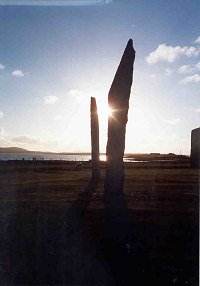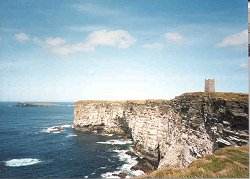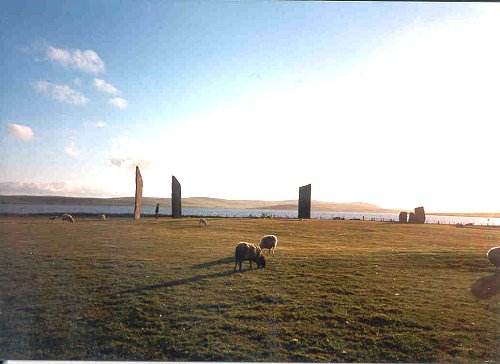
This year's St Magnus Festival (the 24th) was particularly important
by virtue of no less than three world premières by the Festival's
Founder and President Peter Maxwell Davies. The first of these, "Mr Emmet
Takes a Walk", is a music theatre piece entitled a "Dramatic Sonata" (divided
into "Exposition", "Development" and "Recapitulation"). Scored for chamber
forces, it made a strong impression on the opening night of the Festival
(16th June). The libretto is by David Poutney, who collaborated
to impressive effect in the composer's last opera, "The Doctor of Myddfai".
The new work takes the form of a psychodrama, entering the mind of the eponymous
Mr Emmet, a middle-aged businessman, in the last moments before he commits
suicide by laying his head on a railway track. If this sounds relentlessly
grim, the treatment by composer and librettist is full of dark humour and
the witty text inspired the composer to some of his most wryly amusing parodies
of genres despite the serious subject matter. The "black comedy" element
in the piece (such as a Heating Engineer's dramatic arrival to the strains
of the music from the Commendatore's infernal appearance in Mozart's "Don
Giovanni") came off well. The score contains references to J S Bach, Schumann,
Gabrielli and Mozart, these being composers close to Mr Emmet's heart and
Sir Peter weaves these references into his score without sounding in the
least eclectic. The soprano, baritone and bass soloists, who were also required
to act a great deal in the difficult and demanding roles, made a very favourable
impression and managed to hold the audience's interest for the full hour's
duration of the piece. A strangely disturbing and enigmatic piece with some
uneasy messages about the desperation of turn-of-the-century lifestyles lurking
beneath the comic surface, Mr Emmet is a thought-provoking and worthy end
to Sir Peter's work for the theatre.

The second work receiving its first performance at the Festival was "Orkney
Saga V: Westerly Gale in Biscay, Salt in the Bread Broken". It is the latest
in a series of fourteen works in which Sir Peter is depicting in music a
display of sail-like banners which hung in the nave of St Magnus Cathedral
in June 1993 to commemorate the Orkneymen's crusade to Jerusalem in 1151.
"Orkney Saga V" took the form of a seascape as 12th century crusaders
take to the waves and encounter a particularly savage storm. The work begins
with a purely orchestral rondo based on a plainsong which sets the scene
and includes suggestions in the score of dancing and singing before the impending
journey. The sea-passage becomes evermore wave-tossed and tempestuous and
at the height of the mighty storm, a choir cuts through the dense orchestral
textures with a description of the events taken from the Biblical account
of Jonah's storm. A prayer for those at sea, taken from the Roman missal,
is followed by the St Magnus Prayer, a reflective thanksgiving for a safe
passage. The choral writing is noticeably less thorny than that for the orchestra
and in this respect the work is similar to Davies's "Sea Elegy" of 1998,
settings of poems of George Mackay Brown. The Orkney Festival Choir distinguished
themselves and the BBC Philharmonic made light of the extremely taxing orchestral
part.
Sir Peter's substantial 45-minute Seventh Symphony was premièred on 19th June. The most classical of his symphonies, it is a homage to Joseph Haydn and that Austrian Master's capacity to surprise his audiences. The first movement has a Sibelian organic logic, though the first and second "subjects" are sharply contrasted, the one rhythmically crisp, the other lyrical and otherworldly. A recurring section for high-tuned percussion was particularly intriguing. The second movement is a crazed Minuet and Trio reinventing the dance form with a dry wit of which Haydn himself might have approved. The penultimate movement is Sir Peter's most profound symphonic Adagio. The opening simple two- and three-part string textures string are a meant as a tribute to Haydn yet the themes themselves sound intensely Mahlerian. At the intense climax of the movement, Haydn's "Sturm und Drang" period is alluded to but painted on a greatly expanded orchestral canvas. In the final movement, all the thematic strands are interweaved in a monumental "Development" section. The texture begins to unravel near the end of the Finale and the Sir Peter has formulated the last notes so that they can not only lead into the symphony's start but also into the start of the First Symphony. Thus Sir Peter's series is a true "symphonic cycle". Convincingly structured and inventively scored, the Seventh is one of the finest of the composer's symphonies and makes a fitting end to an important cycle.
There was a valedictory feeling to this year's St Magnus Festival as it contained Sir Peter's farewells to music drama and the symphony. However, the quality of the chamber writing in "Mr Emmet Takes Walk" makes the composer's next project, a series of ten string quartets for the Naxos company, something to anticipate with relish.
All three first performances of Sir Peter's new works took place in the Pickaquoy Centre, Kirkwall. The quality of the acoustics of this sports centre put many a traditional concert hall to shame.
Paul Conway

 Return to:
Return to: